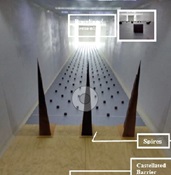Simulation of Atmospheric Boundary Layer Wind Tunnel of Universidad del Valle
Main Article Content
The accurate simulation of wind flow in the atmospheric boundary layer in a wind tunnel is crucial for various engineering applications, spanning fields such as civil and environmental engineering. With the aim of investigating and characterizing the behavior and impact of wind on scaled models of civil structures in the Wind Tunnel of the School of Civil Engineering at the University of Valle, the main objective is to determine the appropriate distribution of turbulence-generating devices to replicate specific velocity profiles required for rural, suburban, and urban exposure types that describe the atmospheric boundary layer. This study is based on reproducing three velocity profiles, representative of urban, suburban, and rural exposures, at a 1:200 scale. To achieve this, full-scale Irwin vortex generators, a castellated barrier, and Counihan and Gartshore roughness elements were implemented. Velocity measurements in the wind tunnel test section were conducted using a hot-wire anemometry system and Pitot tubes. Experimental results obtained by simulating velocity profiles demonstrated an acceptable correspondence with theoretical profiles established in the NSR-10 design code. This study contributes to the advancement in understanding and replicating velocity profiles in the context of simulating the atmospheric boundary layer in wind tunnels in Colombia, supporting key applications in the field of engineering.
Hancock PE, Hayden P. Wind-Tunnel Simulation of Weakly and Moderately Stable Atmospheric Boundary Layers. Boundary-Layer Meteorol. 2018;168:29–57. DOI: https://doi.org/10.1007/s10546-018-0337-7
Barlow JB, Rae WHJ, Pope A. Low Speed Wind Tunnel Testing. Third. John Wiley & Sons, Ltd; 1999. 724 p.
Shojaee SMN, Uzol O, Kurç Ö. Atmospheric boundary layer simulation in a short wind tunnel. Int J Environ Sci Technol. 2014;11(1):59–68. DOI: https://doi.org/10.1007/s13762-013-0371-4
Kozmar H. Truncated vortex generators for part-depth wind-tunnel simulations of the atmospheric boundary layer flow. J Wind Eng Ind Aerodyn. 2011;99(2–3):130–6. DOI: https://doi.org/10.1016/j.jweia.2010.11.001
Richards PJ, Norris SE. Appropriate boundary conditions for a pressure driven boundary layer. J Wind Eng Ind Aerodyn. 2015;142:43–52. DOI: https://doi.org/10.1016/j.jweia.2015.03.003
Avelar AC, Brasileiro FLC, Marto AG, Marciotto ER, Fisch G, Faria AF. Wind tunnel simulation of the atmospheric boundary layer for studying the wind pattern at centro de lançamento de alcântara. J Aerosp Technol Manag. 2012;4(4):463–73. DOI: https://doi.org/10.5028/jatm.2012.04044912
Pires LBM, Roballo ST, Fisch G, Avelar AC, da Mota Girardi R, Gielow R. Atmospheric flow measurements using the PIV and HWA techniques. J Aerosp Technol Manag. 2010;2(2):127–36. DOI: https://doi.org/10.5028/jatm.2010.02027410
Asociación Colombiana de Ingeniería Sísmica. Reglamento Colombiano de Construcción Sismo Resistente NSR-10. Comisión Asesora Permanente para el régimen de Construcciones Sismo Resistentes (Ley 400 de 1997), editor. Bogotá; 2010.
Kuznetsov S, Ribičić M, Pospíšil S, Plut M, Trush A, Kozmar H. Flow and turbulence control in a boundary layer wind tunnel using passive hardware devices. Exp Tech. 2017;41:643–61. DOI: https://doi.org/10.1007/s40799-017-0196-z
Xie D, Xiao P, Cai N, Sang L, Dou X, Wang H. Field and Wind Tunnel Experiments of Wind Field Simulation in the Neutral Atmospheric Boundary Layer. Atmosphere (Basel). 2022;13(12):1–14. DOI: https://doi.org/10.3390/atmos13122065
Hlevca D, Degeratu M. Atmospheric boundary layer modeling in a short wind tunnel. Eur J Mech B/Fluids. 2020;79:367–75. DOI: https://doi.org/10.1016/j.euromechflu.2019.10.003
Hancock PE, Hayden P. Wind-Tunnel Simulation of Approximately Horizontally Homogeneous Stable Atmospheric Boundary Layers. Boundary-Layer Meteorol. 2021;180(1):5–26. DOI: https://doi.org/10.1007/s10546-021-00611-7
Counihan J. An improved method of simulating an atmospheric boundary layer in a wind tunnel. Atmos Environ Pergamon Press. 1969;3:197–214. DOI: https://doi.org/10.1016/0004-6981(69)90008-0
Irwin H. The Design of Spires for Wind Simulation. J Wind Eng Ind Aerodyn. 1981;7:361–6. DOI: https://doi.org/10.1016/0167-6105(81)90058-1
Gartshore IS, De Croos KA. Roughness Element Geometry Required for Wind Tunnel Simulations of the Atmospheric Wind. Am Soc Mech Eng. 1976;(76-WA/FE-18):480–5. DOI: https://doi.org/10.1115/1.3448821
Kozmar H. Characteristics of natural wind simulations in the TUM boundary layer wind tunnel. Theor Appl Climatol. 2011;106(1–2):95–104. DOI: https://doi.org/10.1007/s00704-011-0417-9
Hongtao XU, Mingshui LI, Haili LIAO YH. Simulation of Atmosphere Boundary Layer by Using Wedges and Rough Elements Technique. J Highw Transp Res Dev. 2011;5(1):41–4. DOI: https://doi.org/10.1061/JHTRCQ.0000040
Chen Z, Wei C, Chen Z, Wang S, Tang L. Numerical Simulation of Atmospheric Boundary Layer Turbulence in a Wind Tunnel Based on a Hybrid Method. Atmosphere (Basel). 2022;13. DOI: https://doi.org/10.3390/atmos13122044
- helene tischer, Johannio Marulanda, Peter Thomson, Effect of seismic retrofit on the dynamic behavior of a building damaged by the Pizarro earthquake , Ingeniería y Competitividad: Vol. 8 No. 2 (2006)
- Sebastián Vélez Loaiza, Profesor, Profesor, Profesor, Profesor, Profesor, 3d printing applied to building development around the world: a systematic literature review , Ingeniería y Competitividad: Vol. 25 No. Suplemento (2023): Edición Especial
Accepted 2024-04-26
Published 2024-05-28

This work is licensed under a Creative Commons Attribution-NonCommercial-ShareAlike 4.0 International License.
Authors grant the journal and Universidad del Valle the economic rights over accepted manuscripts, but may make any reuse they deem appropriate for professional, educational, academic or scientific reasons, in accordance with the terms of the license granted by the journal to all its articles.
Articles will be published under the Creative Commons 4.0 BY-NC-SA licence (Attribution-NonCommercial-ShareAlike).





